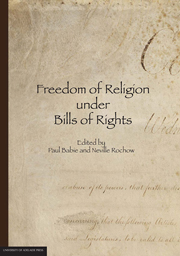Book contents
- Frontmatter
- Contents
- Acknowledgments
- List of Contributors
- Foreword by The Hon Sir Anthony Mason AC KBE: Human Rights and Courts
- INTRODUCTION
- SETTING THE SCENE
- CONTEMPORARY FREEDOM OF RELIGION ISSUES
- COMPARATIVE EXPERIENCE WITH FREEDOM OF RELIGION
- 9 Political Culture and Freedom of Conscience: A Case Study of Austria
- 10 The Sky is Falling if Judges Decide Religious Controversies! – Or is it? The German Experience of Religious Freedom Under a Bill of Rights
- 11 Religious Freedom in a Secular Society: The Case of the Islamic Headscarf in France
- 12 Religious Freedom in the UK after the Human Rights Act 1998
- 13 Judicial Interpretation, Neutrality and the US Bill of Rights
- 14 Protecting Religious Freedom: Two Counterintuitive Dialectics in US Free Exercise Jurisprudence
- 15 Walking the Tightrope: The Struggle of Canadian Courts to Define Freedom of Religion under the Canadian Charter of Rights and Freedoms
- 16 Quo Vadis The Free Exercise of Religion? The Diminishment of Student Religious Expression in US Public Schools
- 17 Freedom from Discrimination on the Basis of Religion
- 18 Ruminations from the Shaky Isles on Religious Freedom in the Bill of Rights Era
- 19 Indigenous Peoples and Bills of Rights
- TABLE OF LEGISLATION AND INTERNATIONAL INSTRUMENTS
- INDEX
16 - Quo Vadis The Free Exercise of Religion? The Diminishment of Student Religious Expression in US Public Schools
from COMPARATIVE EXPERIENCE WITH FREEDOM OF RELIGION
Published online by Cambridge University Press: 05 June 2013
- Frontmatter
- Contents
- Acknowledgments
- List of Contributors
- Foreword by The Hon Sir Anthony Mason AC KBE: Human Rights and Courts
- INTRODUCTION
- SETTING THE SCENE
- CONTEMPORARY FREEDOM OF RELIGION ISSUES
- COMPARATIVE EXPERIENCE WITH FREEDOM OF RELIGION
- 9 Political Culture and Freedom of Conscience: A Case Study of Austria
- 10 The Sky is Falling if Judges Decide Religious Controversies! – Or is it? The German Experience of Religious Freedom Under a Bill of Rights
- 11 Religious Freedom in a Secular Society: The Case of the Islamic Headscarf in France
- 12 Religious Freedom in the UK after the Human Rights Act 1998
- 13 Judicial Interpretation, Neutrality and the US Bill of Rights
- 14 Protecting Religious Freedom: Two Counterintuitive Dialectics in US Free Exercise Jurisprudence
- 15 Walking the Tightrope: The Struggle of Canadian Courts to Define Freedom of Religion under the Canadian Charter of Rights and Freedoms
- 16 Quo Vadis The Free Exercise of Religion? The Diminishment of Student Religious Expression in US Public Schools
- 17 Freedom from Discrimination on the Basis of Religion
- 18 Ruminations from the Shaky Isles on Religious Freedom in the Bill of Rights Era
- 19 Indigenous Peoples and Bills of Rights
- TABLE OF LEGISLATION AND INTERNATIONAL INSTRUMENTS
- INDEX
Summary
The US Supreme Court ‘bristles with hostility to all things religious in public life’
The first sixteen words of the First Amendment to the United States Constitution, according to which ‘Congress shall make no law respecting an establishment of religion, or prohibiting the free exercise thereof’, contains an inherent conflict between its clauses that has generated more litigation at the Supreme Court than any education-related topic in its history. In other words, while Americans are free to believe in what they wish, the US Supreme Court and other courts have interpreted the First Amendment as not permitting the government from taking any actions, such as aiding religious institutions or permitting prayer in state-sponsored activities such as public schools, for fear of establishing a state religion. At the same time, although the Federal Constitution forbids Congress from establishing religion, since the Supreme Court extended the same prohibition to state governments, individuals have the same rights against the federal or state governments with regard to religion in the public marketplace (state constitutions typically include similar provisions).
When disputes arise under the First Amendment with regard to prayer and religious expression by students in public schools, the lack of judicial clarity, coupled with what can be interpreted as judicial hostility, has led to the near banishment of many student-led religious activities in many public schools. This unhappy state of affairs with regard to the Religion Clauses resulted in large part by the Supreme Court's inability to create separate and distinct standards when dealing with the Establishment and Free Exercise Clauses.
- Type
- Chapter
- Information
- Freedom of Religion under Bills of Rights , pp. 349 - 364Publisher: The University of Adelaide PressPrint publication year: 2012



